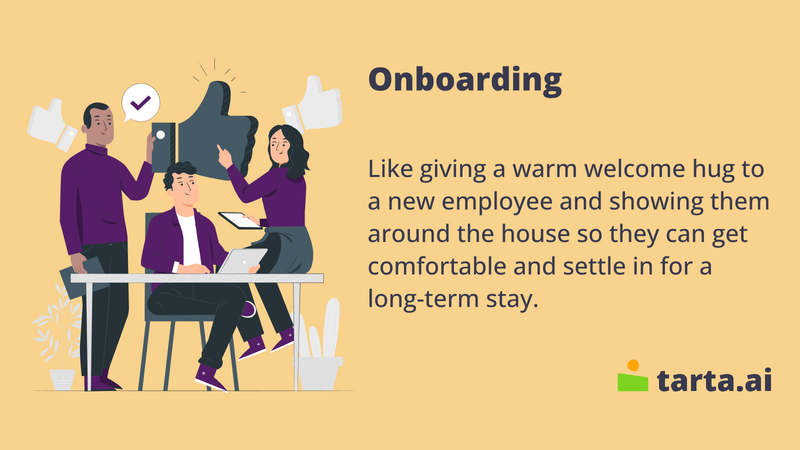The Importance of Onboarding: Setting Employees Up for Success
Onboarding refers to the process of integrating new hires into an organization and preparing them to become productive members of the team. It encompasses various activities, such as orientation, training, and ongoing support, that aim to familiarize new employees with the company's culture, values, policies, and procedures.

Effective onboarding is crucial to the success of an organization. It provides numerous benefits, including reduced turnover rates, improved employee retention, increased job satisfaction, enhanced productivity, and better employee engagement. Additionally, a well-designed onboarding program can help organizations attract and retain top talent, improve their brand reputation, and foster a positive workplace culture.
The purpose of this article is to highlight the importance of onboarding and provide insights into how organizations can set their new employees up for success. It will explore the benefits of onboarding, the key components of an effective onboarding program, and best practices for successful onboarding.
Benefits of Onboarding
- Reduced Turnover Rates
One of the primary benefits of onboarding is that it can significantly reduce turnover rates. Effective onboarding programs can help new hires feel more connected to their new organization and reduce the likelihood that they will leave the company prematurely. This can save organizations time and money by reducing recruitment and training costs.
- Improved Employee Retention
Onboarding can also improve employee retention rates. When new hires feel welcomed and supported during the onboarding process, they are more likely to stay with the organization in the long term. This can help organizations retain valuable talent and reduce turnover rates.
- Increased Job Satisfaction
Onboarding can also increase job satisfaction among new hires. When employees have a clear understanding of their role within the organization, and receive adequate training and support, they are more likely to feel confident and satisfied in their job. This can lead to improved job performance and higher levels of employee engagement.
- Improved Productivity
Effective onboarding programs can also help new hires become productive more quickly. By providing them with the necessary tools, resources, and training, organizations can help new employees become proficient in their role faster. This can help organizations achieve their business goals more quickly and efficiently.
- Enhanced Employee Engagement
Finally, onboarding can enhance employee engagement. When new hires feel connected to the organization and its values, they are more likely to be engaged and committed to their work. This can lead to higher levels of employee morale, better teamwork, and improved performance.
Interesting fact:
Organizations with a standardized onboarding process reported 50% higher new hire productivity and 54% higher employee engagement.
Onboarding offers numerous benefits for organizations, including reduced turnover rates, improved employee retention, increased job satisfaction, improved productivity, and enhanced employee engagement. By investing in effective onboarding programs, organizations can set their new employees up for success and achieve their business objectives more efficiently.
Components of an Effective Onboarding Program
- Pre-boarding Phase
The pre-boarding phase is the period before the new hire's start date. During this phase, organizations can set the tone for the onboarding experience and help new hires feel welcomed and supported. Two critical components of this phase include:
- Communication with the new hire: Organizations should stay in regular communication with new hires to provide them with essential information, such as their start date, job responsibilities, and what to expect during the onboarding process. This can help new hires feel more prepared and reduce anxiety about their new role.
- Orientation preparation: Organizations should also prepare for the new hire's arrival by ensuring that all necessary paperwork is completed and that the new hire's workspace is ready. This can help new hires feel welcomed and valued from day one.
- Orientation Phase
The orientation phase is the period immediately following the new hire's start date. During this phase, organizations should focus on introducing new hires to the company culture, values, and policies. Key components of this phase include:
- Introduction to company culture and values: Organizations should communicate their values, mission, and culture to new hires to help them understand the company's vision and how their role fits into it.
- Overview of company policies and procedures: New hires should also receive an overview of the company's policies and procedures, such as HR policies, safety protocols, and IT policies. This can help new hires understand what is expected of them and how to navigate the organization effectively.
- Introduction to team members and stakeholders: Organizations should introduce new hires to their team members and other key stakeholders. This can help new hires build relationships and feel more connected to the organization.
- Integration Phase
The integration phase is the period following orientation and focuses on helping new hires become productive members of the team. Key components of this phase include:
- Training and development: Organizations should provide new hires with the necessary training and development opportunities to help them succeed in their role. This may include job-specific training, skills development, or mentorship programs.
- Regular feedback and coaching: New hires should receive regular feedback and coaching to help them improve their performance and develop their skills.
- Mentorship and support: Organizations should also provide new hires with mentorship and support to help them navigate the organization effectively and build relationships with their colleagues.
- Ongoing Support Phase
The ongoing support phase is the period following integration and focuses on maintaining engagement and support for new hires. Key components of this phase include:
- Continuous training and development: Organizations should provide ongoing training and development opportunities to help new hires continue to develop their skills and knowledge.
- Ongoing communication and feedback: New hires should continue to receive regular feedback and communication to help them stay engaged and informed about the organization.
- Career growth opportunities: Organizations should provide new hires with opportunities for career growth and advancement. This can help them feel more connected to the organization and motivated to succeed.

Photo: Mimi Thian/Unsplash
An effective onboarding program should include pre-boarding, orientation, integration, and ongoing support phases. By focusing on each of these components, organizations can set their new employees up for success and improve overall employee retention and engagement.
Onboarding Best Practices
While every organization's onboarding program may differ based on its unique needs, there are some best practices that can help ensure a successful onboarding experience. These include:
Practice | Description |
Tailor Onboarding to Meet the Needs of New Hires | Organizations should tailor their onboarding program to meet the needs of each new hire. This may include customizing the training and development program to the new hire's job responsibilities or providing specific resources based on the new hire's background and experience. By tailoring the onboarding program to meet the needs of each new hire, organizations can help ensure that the new hire feels supported and engaged from day one. |
Assign Onboarding Responsibilities to Multiple Stakeholders | Effective onboarding should involve multiple stakeholders, including HR, managers, and team members. Each stakeholder should have specific responsibilities to ensure that the onboarding process runs smoothly. For example, HR may be responsible for administrative tasks such as paperwork, while managers may be responsible for providing job-specific training and development. By assigning onboarding responsibilities to multiple stakeholders, organizations can ensure that new hires receive the necessary support and resources to succeed. |
Provide Resources and Tools for New Hires to Succeed | Organizations should provide new hires with the necessary resources and tools to succeed in their role. This may include access to software or technology, training materials, or mentorship programs. By providing new hires with the necessary resources and tools, organizations can help new hires feel more confident and prepared to take on their job responsibilities. |
Obtain Feedback from New Hires and Make Improvements | Organizations should regularly obtain feedback from new hires regarding their onboarding experience. This can help organizations identify areas for improvement and make necessary changes to ensure a more successful onboarding process in the future. By obtaining feedback from new hires and making improvements, organizations can improve overall employee satisfaction and retention. |
Interesting fact:
The cost of replacing an employee can range from 16% to 213% of their annual salary. A well-designed onboarding program can help reduce turnover and save organizations money in the long run.
In conclusion, onboarding is a critical process for setting new hires up for success and improving overall employee engagement and retention. A well-designed onboarding program can reduce turnover rates, increase job satisfaction, improve productivity, and enhance employee engagement.
To implement or improve an onboarding program, organizations should focus on tailoring the program to meet the needs of new hires, assigning onboarding responsibilities to multiple stakeholders, providing resources and tools for new hires to succeed, and obtaining feedback to make improvements.
By prioritizing the onboarding process, organizations can set new hires up for success and foster a positive company culture. Investing in an effective onboarding program is not only beneficial for new hires but can also lead to long-term benefits for the organization, including increased employee retention and productivity.
- Onboarding is a critical process for setting new hires up for success and improving overall employee engagement and retention.
- A well-designed onboarding program can reduce turnover rates, increase job satisfaction, improve productivity, and enhance employee engagement.
- The components of an effective onboarding program include the pre-boarding, orientation, integration, and ongoing support phases.
- Best practices for onboarding include tailoring the program to meet the needs of new hires, assigning onboarding responsibilities to multiple stakeholders, providing resources and tools for new hires to succeed, and obtaining feedback to make improvements.
- Investing in an effective onboarding program is not only beneficial for new hires but can also lead to long-term benefits for the organization, including increased employee retention and productivity.
FAQ
How long does the onboarding process typically take?
The onboarding process can take anywhere from several days to several months, depending on the organization and the position.
Is onboarding only important for entry-level positions?
No, onboarding is important for all positions and levels within an organization. Even senior executives can benefit from a positive onboarding experience.
How can organizations measure the success of their onboarding program?
Organizations can measure the success of their onboarding program by tracking metrics such as employee retention rates, productivity levels, and feedback from new hires.